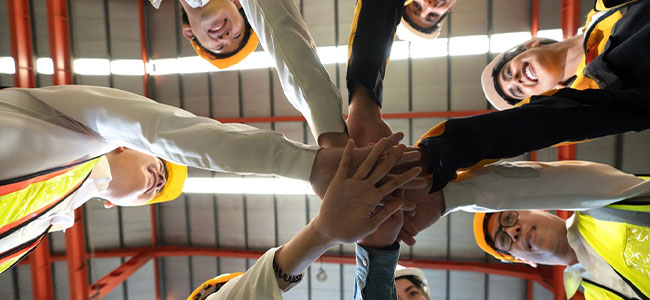
Protect Workers and Company Reputation with a Culture of Safety
Creating and promoting a culture of safety can mitigate the risk of hazardous conditions across the organization.
- By Duane Duhamel
- Oct 27, 2023
A strong safety culture is critical to maintaining employee trust and minimizing occupational risks on the job. But when business leaders don’t emphasize workplace health and safety, they don’t just contribute to hazardous conditions in the organization. They put workers at risk and their company's reputation on the line.
And as the severity and frequency of incidents rise, so do the consequences. Incidents resulting from a lack of safety culture can lead to operational delays, significant financial losses and legal repercussions.
However, proactively creating and promoting a culture of safety throughout the organization and encouraging employee participation can mitigate these risks. Through deliberate actions, business leaders can avoid financial issues, enhance operational efficiency and ultimately build a stronger reputation.
The Consequences of Neglecting Worker Safety
The consequences of not having a strong safety culture within an organization are multi-faceted and far-reaching. One of the most immediate and concerning outcomes is the increased potential for incidents and injuries on the job site. Without a proactive strategy for identifying and mitigating workplace hazards, employees are at a higher risk of injuries and illnesses.
Organizations without an entrenched safety culture also run into negative environmental impacts and legal implications. Non-compliance with safety regulations and failure to provide a safe working environment can result in costly legal actions, fines and penalties, therefore draining financial resources.
Additionally, work disruptions aren’t confined to the incident itself. Follow-on incident investigations often hold up work until the cause is identified and corrective actions are effectively implemented. This downtime can impact productivity, delay project timelines and increase costs.
All of this adds up to perhaps one of the most chronic and pervasive consequences: reputational damage.
Organizations that neglect health and safety risk not only the physical well-being of their employees but also their standing in the industry and community. A poor safety record can deter potential clients, partners and workers from associating with the organization, ultimately affecting the bottom line and long-term growth.
3 Steps to Foster a Culture of Safety
An organization’s safety culture includes the set of attitudes, values, norms, beliefs and practices that its employees and contractors share when it comes to preventing workplace incidents. This almost always means going above and beyond the minimum regulatory requirements. To improve overall safety performance and protect the organization’s reputation, employers need to foster a robust safety culture. As with changing any aspect of workplace culture, creating a safety-first culture takes time, patience and persistence — but it’s worth the effort to protect the well-being of workers and the company itself.
Here are three things to do — and keep doing — to ensure safety is always top-of-mind for employees and contractors throughout the organization:
- Speak directly with workers and gather feedback.
One of the most important actions a leader can take to promote workplace safety and educate employees about safety risks is to spend time with frontline workers to understand the hazards and risks associated with their work. This can be achieved by engaging in activities like safety walks or site visits to speak directly with workers about safety improvements.
Ask employees questions like "What safety concerns have you observed?" and "How can we make this workplace safer for you?" An open dialogue demonstrates true dedication to their well-being and enables employers to actively seek input from them.
Additionally, soliciting formalized feedback from the workforce can provide insights into the organization’s current safety culture. This feedback serves as a critical baseline, helping assess where the company stands in terms of safety practices and perceptions, making it possible to more effectively track progress.
- Encourage employee involvement in safety-related initiatives.
Employee involvement is the core of a strong safety culture. Encourage the workforce to actively participate in safety-related initiatives, including safety committees and meetings where their perspectives and insights can help shape policies and practices.
Create an environment that encourages and values employee input when it comes to incident reporting and hazard identification by instituting a no-blame reporting policy. When workers feel confident that they won't be negatively impacted when reporting incidents, employers can gain better insights into safety risks that would otherwise be overlooked.
Workers should also be involved and kept updated on critical safety activities such as inspections and training sessions. This active participation reinforces the emphasis on health and safety throughout the organization, making safety a shared responsibility.
- Lean on data and analytics
Data and analytics can lead to continuous improvements in safety culture.
Implement a robust system for measuring safety performance that encompasses both leading and lagging indicators. These indicators provide valuable insights into current safety practices and can help predict future trends. This data can help employers understand where the most significant opportunities for improvement lie and create action plans.
Establishing a process to regularly reassess the maturity of a safety culture is also critical. Tracking trends consistently over time enables the employer to identify areas for enhancement and new opportunities as they arise. Moreover, a commitment to ongoing improvement ensures that the safety culture remains agile and adaptable to the evolving needs of the organization.
Place workforce safety at the center of the business as a core value
Maintaining a strong reputation starts with taking care of the workforce. To foster a culture of safety, encourage employees to become involved in the process and use data and analytics to track trends and best practices. When leadership support and worker engagement are aligned, risks can be identified and properly mitigated before the company's reputation or — worse — human lives are endangered.